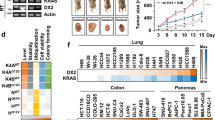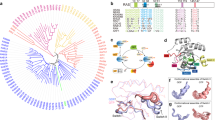Abstract
Raf-1 is a cytosolic serine-threonine kinase that plays an important role in tumor cell growth, proliferation, and apoptosis. Upregulated Raf-1 activity has also been implicated in tumor angiogenesis and metastasis. In this study, we used a promising new RNA interfering technology that targets Raf-1 mRNA both in vitro and in vivo. We initially found that Raf-1 siRNA markedly reduced Raf-1 mRNA in MDA-MB-435 cells in vitro by approximately 75% compared to control siRNA treatment groups. Raf-1 siRNA also reduced cell number by inducing apoptosis in a number of cell lines including HUVEC, MDA-MB-435, and C6 cells. After screening several histidine–lysine polymers in complex with Raf-1 siRNA to reduce tumor growth, we further evaluated the efficacy of this siRNA in complex with the optimal histidine–lysine carrier to reduce the tumor growth in vivo. MDA-MB-435 xenografts treated by intratumoral injections of Raf-1 siRNA were significantly reduced compared with the control groups. By the fourth measurement, tumor growth was reduced by nearly 60% in the Raf-1 siRNA treatment group compared with the untreated group (P<.02). Taken together, our data provide evidence that Raf-1 siRNA may be an effective strategy for reducing tumor growth.
This is a preview of subscription content, access via your institution
Access options
Subscribe to this journal
Receive 12 print issues and online access
$259.00 per year
only $21.58 per issue
Buy this article
- Purchase on Springer Link
- Instant access to full article PDF
Prices may be subject to local taxes which are calculated during checkout





Similar content being viewed by others
References
Mercer KE, Pritchard CA . Raf proteins and cancer: B-Raf is identified as a mutational target. Biochim Biophys Acta. 2003;1653:25–40.
O'Neill E, Kolch W . Conferring specificity on the ubiquitous Raf/MEK signalling pathway. Br J Cancer. 2004;90:283–288.
Wang S, Ghosh RN, Chellappan SP . Raf-1 physically interacts with Rb and regulates its function: a link between mitogenic signaling and cell cycle regulation. Mol Cell Biol. 1998;18:7487–7498.
Lau QC, Achenbach TV, Borchers O, Muller R, Slater EP . In vivo pro-apoptotic and antitumor efficacy of a c-Raf antisense phosphorothioate oligonucleotide: relationship to tumor size. Antisense Nucleic Acid Drug Dev. 2002;12:11–20.
Liu X, Yan S, Zhou T, Terada Y, Erikson RL . The MAP kinase pathway is required for entry into mitosis and cell survival. Oncogene. 2004;23:763–776.
Kasid U, Dritschilo A . RAF antisense oligonucleotide as a tumor radiosensitizer. Oncogene. 2003;22:5876–5884.
Grugel S, Finkenzeller G, Weindel K, Barleon B, Marme D . Both v-Ha-Ras and v-Raf stimulate expression of the vascular endothelial growth factor in NIH 3T3 cells. J Biol Chem. 1995;270:25915–25919.
Hood JD, Frausto R, Kiosses WB, Schwartz MA, Cheresh DA . Differential alphav integrin-mediated Ras-ERK signaling during two pathways of angiogenesis. J Cell Biol. 2003;162:933–943.
Khatib AM, Fallavollita L, Wancewicz EV, Monia BP, Brodt P . Inhibition of hepatic endothelial E-selectin expression by C-raf antisense oligonucleotides blocks colorectal carcinoma liver metastasis. Cancer Res. 2002;62:5393–5398.
Rocheleau CE, Downs WD, Lin R, et al. Wnt signaling and an APC-related gene specify endoderm in early C. elegans embryos. Cell. 1997;90:707–716.
Fire A, Xu S, Montgomery MK, Kostas SA, Driver SE, Mello CC . Potent and specific genetic interference by double-stranded RNA in Caenorhabditis elegans. Nature. 1998;391:806–811.
Hammond SM, Bernstein E, Beach D, Hannon GJ . An RNA-directed nuclease mediates post-transcriptional gene silencing in Drosophila cells. Nature. 2000;404:293–296.
Bernstein E, Caudy AA, Hammond SM, Hannon GJ . Role for a bidentate ribonuclease in the initiation step of RNA interference. Nature. 2001;409:363–366.
Hammond SM, Boettcher S, Caudy AA, Kobayashi R, Hannon GJ . Argonaute2, a link between genetic and biochemical analyses of RNAi. Science. 2001;293:1146–1150.
Reynolds A, Leake D, Boese Q, Scaringe S, Marshall WS, Khvorova A . Rational siRNA design for RNA interference. Nat Biotechnol. 2004;22:326–330.
Kim MH, Yuan X, Okumura S, Ishikawa F . Successful inactivation of endogenous Oct-3/4 and c-mos genes in mouse preimplantation embryos and oocytes using short interfering RNAs. Biochem Biophys Res Commun. 2002;296:1372–1377.
Kaul D, Sikand K . Defective RNA-mediated c-myc gene silencing pathway in Burkitt's lymphoma. Biochem Biophys Res Commun. 2004;313:552–554.
Yoshinouchi M, Yamada T, Kizaki M, et al. In vitro and in vivo growth suppression of human papillomavirus 16-positive cervical cancer cells by E6 siRNA. Mol Ther. 2003;8:762–768.
Futami T, Miyagishi M, Seki M, Taira K . Induction of apoptosis in HeLa cells with siRNA expression vector targeted against bcl-2. Nucleic Acids Res Suppl. 2002; (2):251–252.
Li K, Lin SY, Brunicardi FC, Seu P . Use of RNA interference to target cyclin E-overexpressing hepatocellular carcinoma. Cancer Res. 2003;63:3593–3597.
Chen QR, Zhang L, Stass SA, Mixson AJ . Branched co-polymers of histidine and lysine are efficient carriers of plasmids. Nucleic Acids Res. 2001;29:1334–1340.
Zhang L, Gasper WJ, Stass SA, Ioffe OB, Davis MA, Mixson AJ . Angiogenic inhibition mediated by a DNAzyme that targets vascular endothelial growth factor receptor 2. Cancer Res. 2002;62:5463–5469.
Lesoon-Wood LA, Kim WH, Kleinman HK, Weintraub BD, Mixson AJ . Systemic gene therapy with p53 reduces growth and metastases of a malignant human breast cancer in nude mice. Hum Gene Ther. 1995;6:395–405.
Paddison PJ, Caudy AA, Bernstein E, Hannon GJ, Conklin DS . Short hairpin RNAs (shRNAs) induce sequence-specific silencing in mammalian cells. Genes Dev. 2002;16:948–958.
Xia H, Mao Q, Paulson HL, Davidson BL . siRNA-mediated gene silencing in vitro and in vivo. Nat Biotechnol. 2002;20:1006–1010.
Rudin CM, Marshall JL, Huang CH, et al. Delivery of a liposomal c-raf-1 antisense oligonucleotide by weekly bolus dosing in patients with advanced solid tumors: a phase I study. Clin Cancer Res. 2004;10:7244–7251.
Hood JD, Bednarski M, Frausto R, et al. Tumor regression by targeted gene delivery to the neovasculature. Science. 2002;296:2404–2407.
Scheule RK . The role of CpG motifs in immunostimulation and gene therapy. Adv Drug Deliv Rev. 2000;44:119–134.
Yew NS, Wang KX, Przybylska M, et al. Contribution of plasmid DNA to inflammation in the lung after administration of cationic lipid:pDNA complexes. Hum Gene Ther. 1999;10:223–234.
Tousignant JD, Zhao H, Yew NS, Cheng SH, Eastman SJ, Scheule RK . DNA sequences in cationic lipid:pDNA-mediated systemic toxicities. Hum Gene Ther. 2003;14:203–214.
Yew NS, Zhao H, Przybylska M, et al. CpG-depleted plasmid DNA vectors with enhanced safety and long-term gene expression in vivo. Mol Ther. 2002;5:731–738.
Bridge AJ, Pebernard S, Ducraux A, Nicoulaz AL, Iggo R . Induction of an interferon response by RNAi vectors in mammalian cells. Nat Genet. 2003;34:263–264.
Kim DH, Longo M, Han Y, Lundberg P, Cantin E, Rossi JJ . Interferon induction by siRNAs and ssRNAs synthesized by phage polymerase. Nat Biotechnol. 2004;22:321–325.
Sledz CA, Holko M, de Veer MJ, Silverman RH, Williams BR . Activation of the interferon system by short-interfering RNAs. Nat Cell Biol. 2003;5:834–839.
Samuel CE . Knockdown by RNAi-proceed with caution. Nat Biotechnol. 2004;22:280–282.
Czauderna F, Fechtner M, Dames S, et al. Structural variations and stabilising modifications of synthetic siRNAs in mammalian cells. Nucleic Acids Res. 2003;31:2705–2716.
Acknowledgements
We thank Dr. Pamela Talalay for her careful reading and helpful suggestions of this manuscrift. This work was supported by the National Institutes of Health (CA101466).
Author information
Authors and Affiliations
Corresponding author
Rights and permissions
About this article
Cite this article
Leng, Q., Mixson, A. Small interfering RNA targeting Raf-1 inhibits tumor growth in vitro and in vivo. Cancer Gene Ther 12, 682–690 (2005). https://doi.org/10.1038/sj.cgt.7700831
Received:
Published:
Issue Date:
DOI: https://doi.org/10.1038/sj.cgt.7700831
Keywords
This article is cited by
-
History of Polymeric Gene Delivery Systems
Topics in Current Chemistry (2017)
-
Buffering Capacity and Size of siRNA Polyplexes Influence Cytokine Levels
Molecular Therapy (2012)



